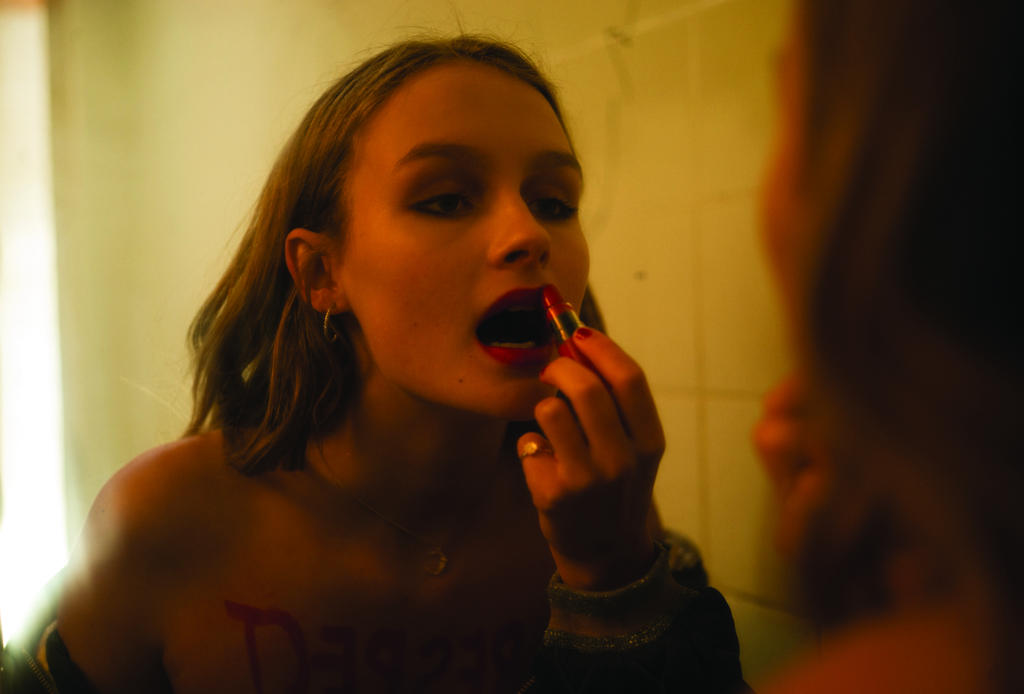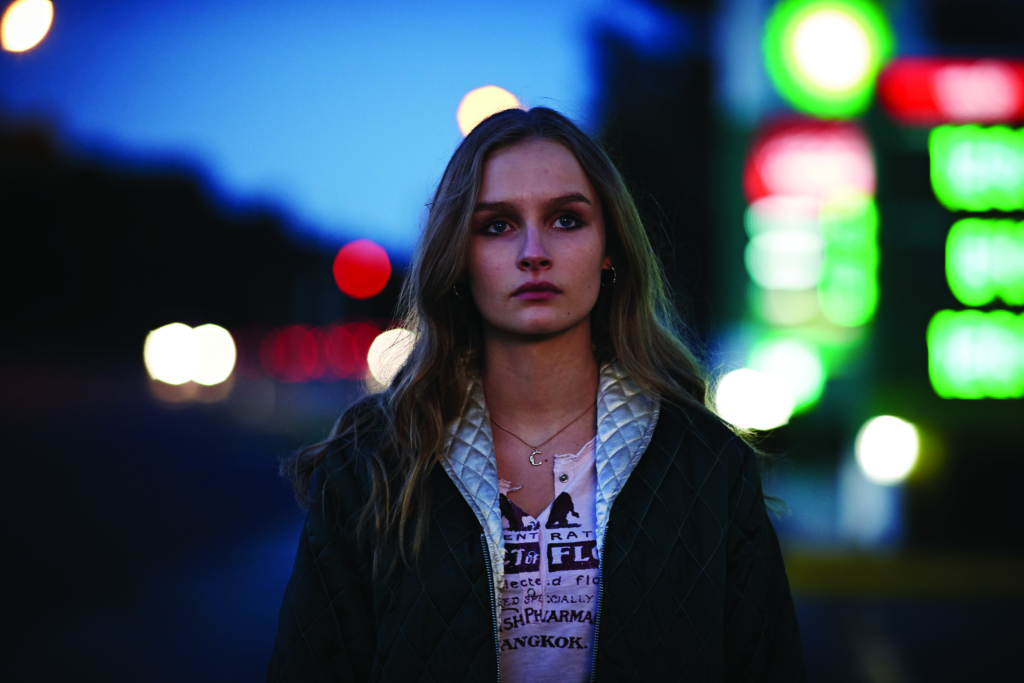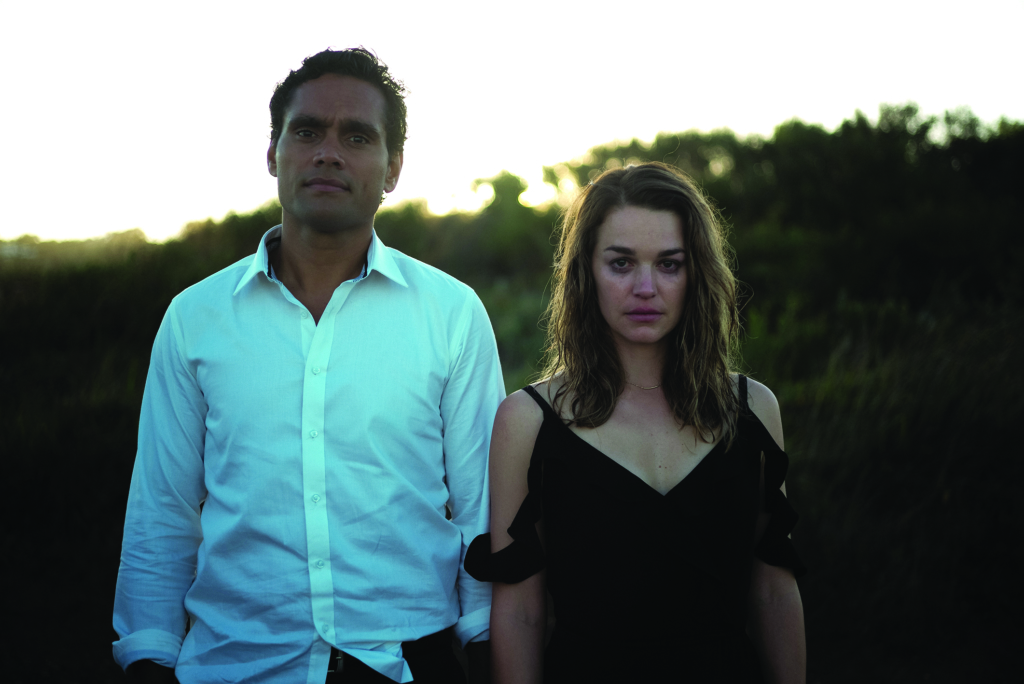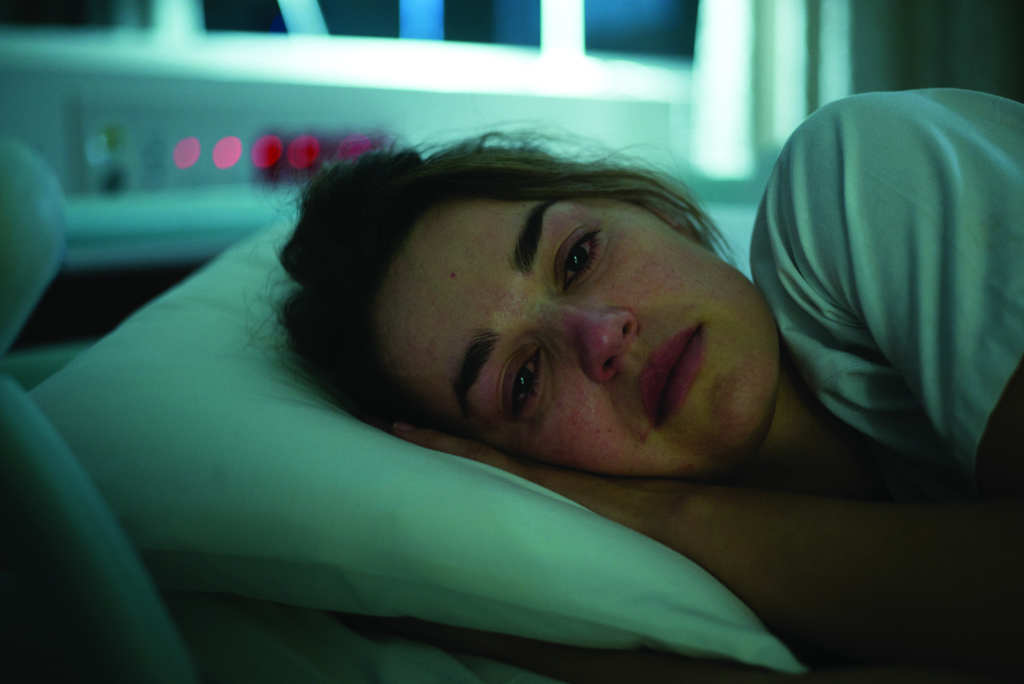Films are surrounded by invisible walls. They’re the categorisations, the genres, the ratings; they exist to keep things orderly and to help shape audience expectations. The walls help us know what is contained within, to compare and contrast with other filmic cities we’ve visited before. These barriers have value, sure – but then are they too constricting? And with films being an extension of society itself, is the existence of filmic barriers stifling growth, stifling art?
Undertow (2018), written and directed by Miranda Nation, tells the story of Claire (Laura Gordon), a married woman who has recently had a late-term miscarriage. The film takes pains to ensure that we, as viewers, experience this trial alongside her: in a key scene, we see her naked, heavily pregnant body lowering itself into a bath, then the water turning red with blood. The fallout from this event plays out quietly: we are shown what the pregnancy has done to her body, the impact it has on her relationship with her loving but perhaps overly protective husband, Dan (Rob Collins), and, most significantly, how it eventually drives her interactions with Angie (Olivia DeJonge), a younger woman who comes into her life at her most vulnerable moment.

Nation explains that, in its simplest form, the film is ‘about a woman who has suffered a loss of a baby and becomes obsessed with a young woman who’s pregnant, [then] starts to project her unresolved grief and desire onto this young woman and her baby’. The writer/director was initially inspired to write the screenplay after performing in a production of Jean Genet’s The Maids. ‘I was just really fascinated by the complex, love–hate relationship between the two sisters,’ she tells me.
So I really wanted to write something that had this central relationship between two women […] Not a romantic or sexual relationship – even though I think there are elements of that in [Undertow] – but just these two women who, on the surface, are very different and seemingly quite polar opposites, but are two sides of the same coin.
‘I really wanted to write something that had this central relationship between two women … who, on the surface, are very different and seemingly quite polar opposites, but are two sides of the same coin.’
—Miranda Nation
With Undertow, Nation has succeeded in creating something unusual and complex: the relationship between Angie and Claire is in turns sinister and fleetingly tender, with a tension that gradually builds the further into the film we get. We watch as Claire, suspecting an affair, starts to follow her husband. Then our heart rates quicken as Claire initiates contact with Angie, posing as a professional photographer and pretending she is interested in the young woman as a subject. Over the course of the film, Claire grows more and more erratic, and Angie increasingly goes off the rails; we witness them descending together, step by step, into the dark. Angie, feeling rejected by everyone around her, and carrying an unwanted baby, shows up to cause a dramatic scene at a black-tie function the football club is throwing. It’s a half-hearted protest but a full-blooded scream at society, yelling in every way other than words about how she has been mistreated and used. At the same function, Claire throws all caution to the wind – quite literally in some ways, as she allows herself to become dangerously intoxicated, then heads off first to the beach and then into the sea with her husband’s best friend, Brett (Josh Helman): a football bad boy and Angie’s on-again, off-again boyfriend.
We also see scenes between Claire and Angie – there’s a violent altercation, and there’s a conversation at the beach in the aftermath of the black-tie function. Yet, while these encounters between the two women are central to the story, there are times when we’re not quite sure whether what we’re watching is ‘truth’, as Claire proves to be an unreliable narrator.

Paralleling this ambiguity, it’s difficult to pin down exactly what Undertow is on genre terms. It’s been described as a ‘psychological thriller’,[1]See, for example, Sarah Ward, ‘Undertow: Melbourne Review’, Screen Daily, 10 August 2018, <https://www.screendaily.com/reviews/undertow-melbourne-review/5131593.article>, accessed 5 March 2019. a ‘character study’[2]See, for example, Mitch Ziems, ‘Undertow Is a Compelling Character Study Elevated by Its Feminine Perspective’, The 8 Percent, 17 August 2018, <https://the8percent.com/undertow-review/>, accessed 5 March 2019. and a ‘drama’.[3]See, for example, Luke Buckmaster, ‘Undertow Review – Intensely Gripping Female-led Australian Drama’, The Guardian, 10 August 2018, <https://www.theguardian.com/film/2018/aug/10/undertow-review-intensely-gripping-female-led-australian-drama>, accessed 5 March 2019. It contains elements of body horror, of regular horror. In light of this, I ask Nation whether she felt that trying to make her film fit within a genre limited what she had sought out to do, and she responds that they ‘were pushed towards genre’. Nation explains further: ‘I think [Undertow’s] more of a drama with some heightened elements.’ She shares, however, that ‘during development, nobody wanted to hear that word: “drama”’.
It’s like no-one knows how to sell a drama. Everyone wants a marketing hook, and genre gives them that hook – you’ve got this supposed target audience that wants to see that type of film.
Even though the script that I took to [producer] Lyn [Norfor] in the first place definitely had these heightened elements – which were glimpses into the protagonist’s subconscious – I wouldn’t have necessarily called it genre. And then people really wanted us to […] call it a psychological thriller, but I still don’t think it really is.
Ultimately, Nation agrees that a preoccupation with genre labels can ‘really limit the scope’:
I’m more interested in exploring the subconscious in a way that is quite poetic and visually symbolic, but not necessarily in a genre film […] You just want to create a film that is what it is. You don’t necessarily need to tick the boxes.

Genre isn’t the only invisible wall to contend with; there are also taboos and cultural expectations. The pressure to make your story conform to certain societal ideals is nothing new: Veronica Mars showrunner Rob Thomas had to fight to keep the sexual-assault storyline in his pilot episode, despite being told it was too dark, as he felt it was necessary to Veronica’s (Kristen Bell) characterisation.[4]See Sadie Gennis, ‘Investigating Veronica Mars: Creator Rob Thomas on the Show’s Enduring Legacy 10 Years Later’, TV Guide, 20 September 2014, <https://www.tvguide.com/news/veronica-mars-rob-thomas-anniversary-1087321/>, accessed 5 March 2019. Joe Wright’s 2005 adaptation of Pride and Prejudice features a saccharine, overtly romantic ending in its US release but not its British one – the result of a negative response to a pre-release test screening in the UK.[5]See Alessandra Stanley, ‘Oh, Mr. Darcy … Yes, I Said Yes!’, The New York Times, 20 November 2005, <https://www.nytimes.com/2005/11/20/weekinreview/oh-mr-darcy-yes-i-said-yes.html>, accessed 5 March 2019. Prior to its acceptance into the Universal fold, Back to the Future (Robert Zemeckis, 1985) was rejected by Disney in outrage about the ‘incest’ storyline between Marty McFly (Michael J Fox) and his mother.[6]See David Konow, ‘How Back to the Future Almost Didn’t Get Made’, Esquire, 9 June 2015, <https://www.esquire.com/entertainment/movies/a35559/back-to-the-future-production/>, accessed 5 March 2019.
In the case of Undertow, the primary way the film pushes against expectation is its presentation of nudity – particularly through depictions of the pregnant body and non-sexualised explorations of Claire’s mindset through the bare physical form. While, traditionally, the pregnant body in film is often framed as a wondrous thing, this isn’t always the case in Undertow, which appropriates body-horror conventions in its confronting portrayals of Angie’s growing belly and Claire’s post-miscarriage body, stretch marks and all. These juxtapositions align with Nation’s description of the pair as existing within a duality: Claire is desperately grieving the pregnancy she’s lost and Angie is trying to ignore one she doesn’t want.

Undertow pushes the pregnant form further than what we are used to seeing. It’s unsettling to watch a pregnant woman binge-drink the way that Angie does; Nation knows this and uses it to skilfully give us insights into Angie’s growing despair. There are also moments when Claire stares at her post-pregnancy body – in the bathroom mirror, or after stripping naked after a run. There is a sense of sacrifice in these images, of giving of yourself physically in order to have a child – and so seeing the markers of this on Claire’s body without the ‘reward’ then makes her loss that much more painful.
‘There’s a sense of betrayal, that your body has let you down … [Claire] sees her body as this barren wasteland that’s killed the baby inside her, and I was really interested in trying to explore all that in terms of her subconscious and the way she feels about it.’
—Miranda Nation
‘I just really wanted to represent the body authentically,’ Nation says, explaining the careful, strategic use of nudity in her film. ‘But then again, I love nudity in films,’ she adds, with a laugh. ‘I love all those European films where it’s just part of the fabric of the story, and it’s not thought of as being risqué or anything. It’s just part of life – we all have bodies.’ In Undertow, nudity is used thoughtfully and purposefully – it demonstrates the natural comfort Claire and her husband have around each other, it underscores awkward moments, and it is also used to explore the ideas and feelings surrounding pregnancy and miscarriage.

Nation points to her own experience of having a child in her late thirties as well as to those of other women she knows who are trying to get pregnant. ‘Some of them can’t […] And there’s that real sense of grief and loss at something that you wanted and couldn’t have.’ The nudity in Undertow is essential to our understanding of this feeling of defeat. ‘Often, there’s a sense of betrayal, that your body has let you down,’ Nation explains.
[Claire] sees her body as this barren wasteland that’s killed the baby inside her, and I was really interested in trying to explore all that in terms of her subconscious and the way she feels about it.
According to the filmmaker, including nudity in such an unglamorous way meant walking a fine line. ‘In Australia and America, we do have a bit of a stigma around nudity,’ she says.
You often see female nudity in a really gratuitous way – women are portrayed as sex objects – so it was really important to us that we never did that. It was something that served the story and really spoke to that exploration of our relationships with our bodies.

Beyond the formal strictures of classification, filmmakers face the unwritten constraints imposed by viewers, particularly those sectors of the audience with paternalistic attitudes about what we ‘should’ be exposed to. However, the less that audiences are exposed to ideas or images that push boundaries and challenge preconceptions, the less likely they are to tolerate the few that do – which can only lead to artistic stagnation and homogenisation in the screen industries. One constraint that Nation specifically points out is male nudity. ‘I am a bit disappointed there is no male nudity [in Undertow] just to balance it out,’ she says. ‘Because of taboos in the industry, it’s much harder to have male nudity on screen.’ The impact of this inclusion on Undertow would have been subtle, but, to Nation, it could have nevertheless assisted in making the film more ‘authentic and gender-balanced’.
Much like the relationship between its central pair of protagonists, Undertow is difficult to define. Yet, in deliberately pushing the boundaries of genre and taboo to explore complex themes, it proves itself an accomplished piece of filmmaking. This achievement, of course, largely comes from the commitment of its creator. When I ask Nation about the film’s journey, she responds:
I think the biggest lesson is how to hold on to your vision throughout such a long process with so many different voices and collaborators. And just trying to stay true to your vision but also allowing it to evolve in the ways that it needs to through collaboration.
Endnotes
| 1 | See, for example, Sarah Ward, ‘Undertow: Melbourne Review’, Screen Daily, 10 August 2018, <https://www.screendaily.com/reviews/undertow-melbourne-review/5131593.article>, accessed 5 March 2019. |
|---|---|
| 2 | See, for example, Mitch Ziems, ‘Undertow Is a Compelling Character Study Elevated by Its Feminine Perspective’, The 8 Percent, 17 August 2018, <https://the8percent.com/undertow-review/>, accessed 5 March 2019. |
| 3 | See, for example, Luke Buckmaster, ‘Undertow Review – Intensely Gripping Female-led Australian Drama’, The Guardian, 10 August 2018, <https://www.theguardian.com/film/2018/aug/10/undertow-review-intensely-gripping-female-led-australian-drama>, accessed 5 March 2019. |
| 4 | See Sadie Gennis, ‘Investigating Veronica Mars: Creator Rob Thomas on the Show’s Enduring Legacy 10 Years Later’, TV Guide, 20 September 2014, <https://www.tvguide.com/news/veronica-mars-rob-thomas-anniversary-1087321/>, accessed 5 March 2019. |
| 5 | See Alessandra Stanley, ‘Oh, Mr. Darcy … Yes, I Said Yes!’, The New York Times, 20 November 2005, <https://www.nytimes.com/2005/11/20/weekinreview/oh-mr-darcy-yes-i-said-yes.html>, accessed 5 March 2019. |
| 6 | See David Konow, ‘How Back to the Future Almost Didn’t Get Made’, Esquire, 9 June 2015, <https://www.esquire.com/entertainment/movies/a35559/back-to-the-future-production/>, accessed 5 March 2019. |





